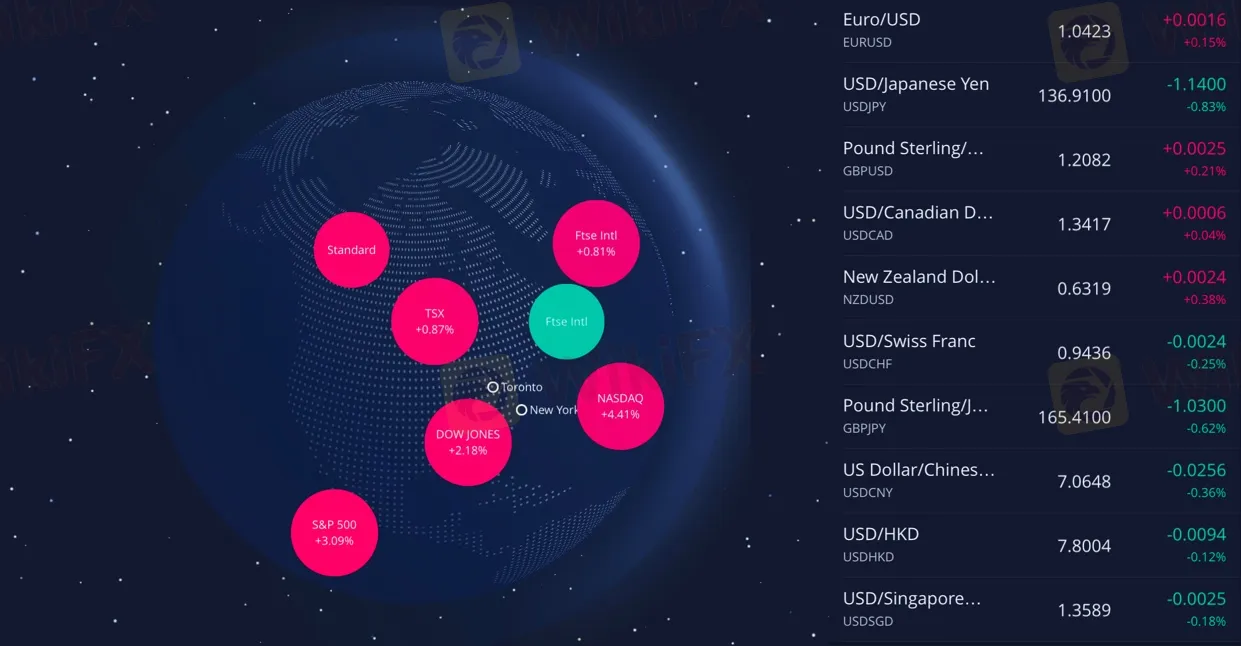Mohicans markets:MHM Today’s News
Abstract:On Friday, December 2, the U.S. November non-farm payrolls data far exceeded expectations, making the market more worried about the Fed's monetary tightening will remain longer; the dollar index, which hit a five-month low during the day, quickly turned up, but turned down after a sharp rise to 105.61, finally closing down 0.22% at 104.51. The offshore yuan approached 7.00 during the day to hit a new high of more than two months.
![第一篇[英语]](https://d126a7rrmtfkku.cloudfront.net/fb_article/2022-12-05/638058511110815461/FB638058511110815461_254566.jpg-article598)

December 5, 2022-Fundamental Reminder
☆ 09:45 China releases Caixin Services PMI for November.
☆ 09:45 ECB President Lagarde delivers a speech. In her last speech, she said the ECB has not set any exchange rate target and is closely monitoring the appreciation of the dollar.
☆ 17:00 Eurozone publishes final value of services PMI for November.
☆ 18:00 Eurozone releases monthly rate of retail sales for October.
☆ 22:45 U.S. releases final value of Markit Services PMI for November.
☆ 23:00 U.S. releases ISM non-manufacturing PMI for November.
MHMarkets -Market Overview
Review of Global Market Trend

On Friday, December 2, the U.S. November non-farm payrolls data far exceeded expectations, making the market more worried about the Fed's monetary tightening will remain longer; the dollar index, which hit a five-month low during the day, quickly turned up, but turned down after a sharp rise to 105.61, finally closing down 0.22% at 104.51. The offshore yuan approached 7.00 during the day to hit a new high of more than two months.
U.S. bond yields also rose and then fell, 2-year U.S. bond yields rose more than 20 basis points to 4.41% during the day, but in the U.S. stock market at midday to give back most of the gains, closing at 4.27%; 10-year U.S. bond yields rose more than 10 basis points to 3.64%, and then turned down to 3.49%.
Commodities had fallen sharply due to the pressure of the dollar rebound, spot gold once fell from above 1800 to near 1778, and then pulled up sharply to approach the 1800 mark again, finally closing down 0.29% at $1797.75/oz. Spot silver fell to 22.26 after a sharp spike to break through the $23 barrier, eventually closing up 1.73% at $23.15 per ounce.
U.S. crude oil and Brent crude oil had fallen more than 2% during the day, with WTI crude oil breaking below the $80 mark intraday, closing down 1.45% at $80.21 per barrel; Brent crude oil forced under the $85 mark, closing down 1.26% at $85.90 per barrel. Continental Europe TTF benchmark Dutch natural gas futures closed down 2.73%, closing lower for the second straight day, but still up for the third straight week last week. U.S. NYMEX January natural gas futures closed down 6.78 percent at $6.2810 per million British thermal units, down for a third straight day and down more than 14 percent last week.
The three major U.S. stock indexes all opened lower, down more than 1% in early trading, but staged a major reversal during the day and ended up, the Dow turned red and closed up 0.1%, after having fallen more than 300 points. The Nasdaq closed down 0.18%, and the S&P 500 index fell 0.12%.
European stocks, except for German stock indexes, generally closed lower. Germany's DAX30 index closed up 0.27%, the FTSE 100 index closed down 0.01%, France's CAC40 index closed down 0.17%, the Euro Stoxx 50 index closed down 0.17%, Spain's IBEX35 index closed down 0.30%, Italy's FTSE MIB index closed down 0.30%.
Hot spots in the market
1. The OPEC+Ministerial Conference decided to keep the oil output policy unchanged, that is, to reduce production by 2 million barrels per day until the end of 2023. The meeting did not discuss measures to cap Russian oil prices.
2. Russian Deputy Prime Minister Novak: Even if it is necessary to reduce production, Russia will not sell oil to countries that implement price limits. Relevant mechanisms and response mechanisms are being developed.
3. At 03:24 on the 5th, a magnitude 6.7 earthquake occurred in the Tonga Islands, with the focal depth of 40 km.
4. Europe and the United States have serious differences over the inflation reduction bill. The largest party group of the European Parliament said that if the United States insists on not making concessions, it will adopt the “nuclear option”.
5. Indonesian authorities have raised the warning level of the eruption of Semeru volcano to the highest level of “Level 4”, and nearly 2000 residents have been evacuated.
6. The global strike in many places continued: the French railway operation was affected, the UK said it was considering using the army, and the President of South Korea would hold a meeting on the strike of truck drivers.
Geopolitical situation
Conflict situation:
1. The spokesman said that two explosions were heard in Zaporoge under the control of Ukraine, and then the alarm was activated.
2. Source: Ukraine plans to blow up the ammonia storage facilities of Odessa Port Factory, and blames the explosion on Russia, in order to prevent Russia from exporting to other countries.
3. The Ukrainian army used the “Haima” rocket to bombard the city of Alchevsk, Lugansk.
4. Kremlin spokesman Peskov: Putin will visit Donbas at an “appropriate time”.
5. The Russian Ministry of Defense announced that the Russian armed forces had successfully attacked Altemovsk.
6. Makron: If Putin agrees to the peace talks, the West should consider Russia's security needs.
Energy situation:
1. Deputy Prime Minister Novak of Russia: If necessary, Russia is prepared to reduce production under the condition of price ceiling (implemented by the West); Oil will not be sold to countries that implement price limiting measures.
2. Zelensky: The upper limit of Russian oil price in western countries is “weak”.
3. Deputy Prime Minister of Moldova: Before December 20, Moldova will not pay 50% of the advance payment for December's natural gas to Gazprom.
4. The Australian government requires states to implement coal price caps.
MHMarkets-Institutional Perspective
1. Goldman Sachs:Bonds seem to be the first choice of asset management companies again
2. SOCIETE GENERALE:The recent rebound in US debt may not indicate an improvement in the situation
3. MUFG:The data strength needs to be impressive to significantly boost the US dollar
Statement | Disclaimer
Disclaimer: The information contained in this material is for general consultation only. It does not take into account your investment objectives, financial situation or special needs. We have made every effort to ensure the accuracy of the information as of the date of publication. MHMarkets makes no warranty or representation on this material. The examples in this material are for illustrative purposes only. To the extent permitted by law, MHMarkets and its employees shall not be liable for any loss or damage arising from any information provided or omitted in this material in any way (including negligence). The characteristics of MHMarkets' products, including applicable fees and charges, are outlined in the product disclosure statement provided on MHMarkets' website. Derivatives may be risky; The loss may exceed your initial payment. MHMarkets recommends that you seek independent advice.
MohicansMarkets, (abbreviation: MHMarkets or MHM, Chinese name: Maihui), Australian Financial Services License No. 001296777.

Read more

Mohicans markets:MHM European Market
Spot gold weakened slightly during the Asian session on Thursday (April 6), hitting a two-day low of $2007.89 per ounce and now trading near $2014.15. A series of weak economic data has fueled fears of an impending recession in the US, giving safe-haven support to the dollar. And some dollar shorts took profits, and gold bulls also took profits ahead of Good Friday and the non-farm payrolls data, putting pressure on gold prices.

Mohicans markets:MHM Today News
On Wednesday, as the less-than-expected March "ADP" data and non-manufacturing PMI data fueled market concerns about an economic slowdown and spurred bets that the Federal Reserve could slow interest rate hikes. Spot gold continued to brush a new high since March last year, which was the highest intraday to $2032.13 per ounce, and then retracted most of the day's gains, finally closing up 0.01% at $2020.82 per ounce; spot silver hovered around $25 during the day, finally closing down 0.21% at $2

Mohicans markets:MHM European Market
Spot gold oscillated slightly lower during the Asian session on Tuesday (April 4) and is currently trading around $1980.13 per ounce. The dollar index rebounded mildly after a big drop overnight, putting pressure on gold prices. However, this week will see the non-farm payrolls report, there is no important economic data out on Tuesday, and the market wait-and-see sentiment is getting stronger.

Mohicans markets :MHM Today News
On Monday, in OPEC + members unexpectedly cut production reignited market concerns about long-term inflation and sparked uncertainty about the Fed's response, the dollar index once up to the 103 mark, and then on a "vertical roller coaster", giving back all the gains of the day and once lost 102 mark, finally closed down 0.53% at 102.04; U.S. 10-year Treasury yields rose and then fell, as data showed that the U.S. economy continues to slow, it fell sharply in the U.S. session, and once to a low
WikiFX Broker
Latest News
Identity Theft in FX: FCA Flags New 'Clone' Broker Mimicking Fortrade
Oron Limited Regulation: A Complete 2025 Review of Its License and Safety
Trade.com Review & Complaints Hidden from New Investors! Tell Different Story
FXCM Broker ASIC Stop Order Halts CFD Sales
Exnova Exposed: Reports of Failed Deposits & Withheld Withdrawals from Traders
The "Profit Eraser" Clause: Why Traders Are Losing Their Gains with Admirals
Souq Capital Exposed: DFSA Warns of Fake Licensing Claims and Unauthorized Status
Is FXCC Regulated? Full FXCC Regulation Overview
Is Tiger Brokers Regulated? Investor Protection Guide
Tag Markets Exposed: Withdrawal Issues, Inflated Spreads & Market Manipulation Concerns
Rate Calc


